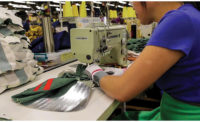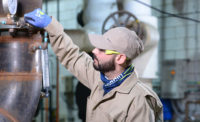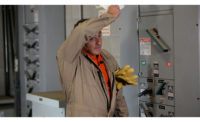While keeping your work teams safe is the obvious focus for anyone involved in choosing PPE, manufacturers are constantly creating new technologies and materials that not only protect your workers, but also offer numerous other benefits. These include extreme comfort, versatility, durability, and sustainability, all of which can significantly improve your safety program, and may even lower your safety spend.
Extreme comfort for better compliance
More comfortable gloves, sleeves, and other safety items mean fewer compliance headaches for you, and increased compliance in turn leads to fewer injuries for your team. Enter the latest technologies in protective materials that are thin, light, and even cool — making workers happy to wear them. You can now get an almost bare-hand feel in anything from general purpose work gloves to the highest ANSI Cut A9 gloves for high-hazard applications.
Higher protection in 21-gauge
One of the latest trends is a move to 21-gauge glove and sleeve constructions that include cut protection. A higher gauge indicates that the material is made of finer yarn with more stitches per inch, creating PPE that’s lighter weight with better dexterity. Pair that with newer knitting technologies, advanced fibers, and quality palm coatings and you get a winning combination of cut resistance, grip, and tactile sensitivity. Workers report that some 21-gauge lines feel as thin as a disposable glove at the fingertips. This makes handling small parts and intricate machine work easy, while keeping the wearer protected.
Improvements in traditional and coreless material constructions
Traditional choices for creating cut-resistant materials use either yarn made with a cut-resistant inner core surrounded by an outer wrap, or coreless yarn infused with strength-enhancing microparticles. While the basic constructions haven’t changed, the materials and yarn-wrapping technologies have. PPE made with tougher core materials and new knitting technologies provide incredible comfort all the way up to ANSI A9 cut resistance that’s fully 50% lighter than comparable materials. Many of these materials are second-skin-thin, making it easy to do the job, even when it includes handling very small parts. And their breathability dissipates moisture and sweat before it causes discomfort.
Coreless materials too have improved, bringing protection all the way up to ANSI Level A6 in a material that’s 30% lighter than comparable fabrics without the use of an inner core that can fray and cause skin irritation. For workers with sensitive skin prone to painful contact dermatitis, coreless materials are a godsend, allowing them to be safe and comfortable in material that feels cool to the touch. Even workers without sensitive skin often choose this material just for the overall comfort.
Tougher Impact Gloves (that aren’t tough to wear!)
Manufacturers are using all the incredible benefits of those various glove shells and applying the latest technologies in impact protection to make gloves that leave old school impact protection in the dust. You’ve enjoyed the flexibility and airflow of TPR flex-point designs for years that allow workers to move their hands naturally in Level 1 and Level 2 impact gloves. But patented new honeycomb TPR patterns bring impact gloves all the way to impact Level 3 with deflection points that allow space in between to provide dexterity and reduce hand fatigue while providing maximum protection from impact injuries. Added ventilation between the honeycombed TPR sections provides up to 9 times more airflow than standard constructions to keep hands cool, dry, and comfortable in some of the most dangerous jobs.
Versatile gloves that grip in multiple environments
Many jobs require workers to move from wet environments to oily to dry, all in the same shift. And while it’s possible to provide your workers with a pair of gloves for each different application, it’s often not practical, and it’s fraught with the probability that they’ll forget to change gloves between one task and another, or that they’ll take one pair off and forget to put the other on.
Another new technology solves this problem with an intelligent palm coating infused with special stabilizers that adapt to differing environments without losing dexterity or grip. That means workers can go from wet, to oily, to dry, and back again without changing gloves, losing grip, or compromising dexterity. Manufacturers are applying this coating to different glove shells for different needs and preferences to create work gloves for any application.
Durability for longer lasting gear
In addition to eliminating the cost and waste of using multiple gloves per shift, new palm coatings can add incredible durability and abrasion resistance. Gloves with the versatile palm coating technology we mentioned above tested at an ANSI Abrasion Level 6, but that was after over 30,000 abrasion testing revolutions — well above the minimum for the highest abrasion level available. That’s 50 percent more abrasion resistance than other palm coatings for a glove that lasts, saving you money and cutting down on waste. In tests, some new, more durable gloves lasted over 63 hours on the job versus a competitive glove that lasted just 4 hours.
Sustainability for greener environmental choices
Glove manufacturers are setting their sights, not just on manufacturing more durable products that help reduce cost and waste, but also on manufacturing with the minimum environmental impact. For example, the traditional process of manufacturing micro-foam nitrile coated gloves wastes an enormous amount of drinkable water. But new techniques for applying a more sustainable foam nitrile coating use absolutely no clean water at all. And the new coating is softer and more flexible than typical nitrile without sacrificing oil or water resistance. Materials can be made even greener by using recycled yarn polymers rather than new yarn. And of course, recyclable packaging can give an easy environmental boost to any product.
So while it can be tempting to think all glove lines are the same, be sure you’re asking the right questions about comfort, construction, versatility, durability, and sustainability to provide the best options for your workers, your bottom line, and the planet.



